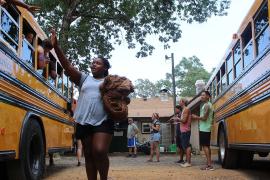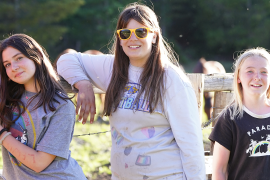Imagine walking into a bunk that feels alive with energy and warmth — a place where campers feel safe, supported, and excited to start their day. As a counselor, you have the unique opportunity to create this magic. The Build-A-Bunk workshop is your roadmap to making it happen. Through your participation in this workshop, you’ll get hands-on, team up with your co-counselors, and design a shared vision for your cabin — a space that becomes the heart of your campers’ summer memories. This isn’t just training; it’s your chance to set the stage for an unforgettable summer.
Your Bunk: The Heart of Camp Life
Your bunk or cabin is more than just a place for campers to sleep. It’s where they’ll form lifelong friendships, overcome challenges, and create unforgettable memories. As a camp counselor, you are at the center of this experience. How you collaborate with your co-counselors and interact with campers directly shapes the tone, structure, and sense of belonging within your bunk. Small moments — like sharing stories, comforting homesick campers, or celebrating even minor achievements — are the building blocks of camp magic.
This interactive, hands-on activity centers around designing and building a detailed model of your bunk or cabin. The act of physically constructing the model is key to this workshop and allows you and your co-counselors to collaborate creatively while thinking deeply about the space you want to create for your campers. It’s not just about the physical structure — it’s a process that fosters teamwork, problem-solving, and meaningful discussions. As you work on the model, you’ll reflect on your campers’ emotional and social needs, and gain a sense of pride and responsibility in shaping their experience. By taking ownership of your cabin’s culture through this model-building activity, you’re setting the foundation for an environment where every camper can feel included and thrive.
Why This Activity Is Essential for Your Summer Success
The Build-A-Bunk workshop equips you with tools for success in four key areas:
Build strong co-counselor connections. Collaboration is the backbone of any successful cabin. This workshop fosters open communication, aligned goals, and mutual trust. Think of this as your chance to establish a rhythm that supports everyone and enhances the camper experience. A strong co-counselor partnership means smoother camper management and a happier bunk.
Prepare for camper dynamics: Every bunk has its unique personalities, challenges, and opportunities. This workshop encourages discussions about potential scenarios and proactive strategies. You’ll feel more confident addressing homesickness, managing conflicts, and supporting campers who need extra encouragement. The goal is to ensure every camper feels seen, valued, and supported.
Create unique cabin traditions. Traditions bring life to your bunk that foster connections and add excitement. Use this workshop to brainstorm creative ideas that reflect your group’s unique energy. Shared rituals can turn ordinary moments into treasured memories.
Think critically about your role. You are a mentor, role model, and community builder. This workshop helps you reflect on your strengths and how they complement those of your co-counselors. It challenges you to think intentionally about how to foster inclusion, resolve conflicts, and create joy within your cabin.
By engaging fully in this workshop, you’re not just preparing for the summer — you’re laying the groundwork for lifelong connections and memories.
How to Run Build-A-Bunk
This workshop is straightforward, fun, and impactful. Using simple materials like recycled cardboard, craft supplies, or kits, you’ll build a model of your cabin while discussing what kind of culture you want to create for your campers.
1. Break the Ice
Before you jump fully into the building activity, spend a few moments getting to know your co-counselors to help you feel more comfortable and connected with each other. Start with light and engaging icebreakers to help better understand each other:
- Are you an early bird or a night owl?
- Do you prefer a neat and tidy space, or are you more comfortable with a little organized chaos?
- What’s your favorite way to unwind after a long day?
- What’s one thing that helps you feel comfortable in shared spaces?
- What’s a personal item you brought to camp and why?
- If you could sum up your perfect summer at camp in one word, what would it be?
These questions help create a relaxed atmosphere and set the stage for open communication and teamwork.
2. Reflect on Cabin Culture
After building connections through icebreakers, shift to a group discussion about cabin culture. Explore key questions to align your vision as co-counselors:
- What can we do to make every camper feel that they belong?
- How does the cabin’s physical space influence camper behavior?
- What kinds of routines and traditions might help campers feel connected and supported?
This discussion helps counselors recognize their role as community leaders and sets the tone for the collaborative activity ahead.
3. Building Your Bunk
Divide into small groups with your co-counselors to design and build a model of your cabin. Focus on teamwork and creativity over perfection. Use materials such as:
Cardboard or recycled supplies. Use reclaimed cardboard, tape, markers, and other craft supplies to keep costs low and encourage resourcefulness. Think about ways to creatively represent bunk beds, storage spaces, or shared areas.
Prefabricated building kits/materials. These can provide an ideal solution for hands-on cabin-building exercises. A number of such products are available through school supply and STEM activities companies, such as 3DuxDesign and MindWare.
Camper ID cards. Create camper ID cards that include a photo of the camper alongside key information from the director and parents. Think about how to include quiet areas, collaborative spaces, or sensory-friendly zones based on these profiles.
Your model doesn’t have to be perfect — focus on teamwork and how the design reflects your shared vision.
4. Share Your Vision
Present your cabin model to other groups of counselors. Share:
- Key features of their design and the thinking behind them
- A new routine, tradition, or team approach you’re excited to try
- What you learned about working with your co-counselors during the process
This sharing session fosters collaboration across teams and inspires new ideas for the entire camp community.
5. Address Real-Life Camper Scenarios
Follow the building activity with a discussion about camper dynamics. Introduce “camper profiles” that reflect common needs and challenges, such as:
- A camper experiencing homesickness
- A camper with sensory sensitivities
- A camper who struggles with group activities or attention-seeking behaviors
Discuss strategies as a team to make the camper feel welcome and supported. Role-playing helps you develop confidence and empathy for handling these situations during the summer.
6. Involve Campers Once They Arrive
Once your campers arrive, use elements of the Build-A-Bunk activity to help them feel part of the process. Encourage campers to:
- Decorate the cabin with personal touches. Provide craft supplies for them to make signs, decorations, or memory boards.
- Suggest cabin traditions. Hold a group discussion in which campers share ideas for cheers, bedtime routines, or special weekly rituals.
- Create a “camper code.” Work together to establish guidelines for respect, teamwork, and fun in the cabin.
When you involve your campers in shaping their environment, you empower them to take pride in their space and foster a stronger sense of belonging.
Examples of Bunk Traditions and Rituals
Establishing rituals and traditions in the bunk helps create a unique sense of community. Consider incorporating these ideas:
- Morning cheers. Start the day with an energetic bunk cheer that gets everyone excited and builds team spirit.
- High fives at the door. Make it a tradition for every camper to give a high five when entering or leaving the cabin.
- High-low-haha. Each night, gather for a brief circle where everyone shares a “high” (best moment), a “low” (challenging moment), and a “haha” (funniest moment) from their day.
- Theme days. Pick fun themes for certain days, such as Pajama Breakfast or Wacky Hair Wednesday.
- Camper spotlights. Dedicate time each day to celebrate a camper’s unique talents or contributions, such as sharing a skill or recounting a positive moment.
These small but impactful rituals strengthen the bonds between campers and counselors, making the cabin feel like a true home away from home.
Tips for Maintaining Cabin Culture Throughout the Summer
The effort to build a strong cabin culture doesn’t end with this workshop. Here are ways to keep the momentum going all summer:
- Schedule regular check-ins. Schedule a regular meeting with your co-counselors to discuss how your cabin culture is evolving. Reflect on what’s working well and where adjustments might be needed.
- Adapt traditions. Stay flexible. If a routine or tradition doesn’t resonate with your campers, don’t be afraid to adjust or introduce something new that better fits their needs.
- Recognize milestones. Celebrate achievements within the cabin. Whether it’s resolving a conflict, helping a homesick camper feel at home, or a camper trying something new, acknowledge these moments to reinforce a positive and supportive culture.
These ongoing efforts help ensure that the values and traditions you establish continue to thrive and will make the summer even more impactful for your campers.
Wrapping Up
Build-A-Bunk is more than just a creative project. It’s your chance to set the foundation for a successful summer. By working together, sharing ideas, and thinking critically about your role, you’ve created a blueprint for a cabin environment in which campers will thrive.
The Build-A-Bunk workshop equips you with the tools to make an immediate impact on your campers. You’ll leave this training not only with a physical model but with a deeper understanding of what it takes to create a joyful cabin culture that is both inclusive and impactful. Every moment you invest in this activity is a moment invested in your campers’ happiness, growth, and success.
Your leadership has the power to set the tone for the entire summer. Whether it’s through consistent effort, small acts of kindness, or innovative ideas, you can help create a cabin where campers feel safe, valued, and inspired. Reflect on the traditions you’ve established and keep them alive throughout the season. Remember, the connections you build in your bunk have the potential to shape lifelong memories for your campers — and for yourself.
Photo courtesy of Camp Wood YMCA, Elmdale, KS.
Allison Miller is the CEO and founder of Happy Camper Live, a platform dedicated to bringing the magic of summer camp to kids all year long. With over 25 years of experience as a director at the ACA-accredited Camp Starlight in Pennsylvania, Allison is known for creating innovative programs that inspire and engage campers and staff alike. As a lead ACA standards visitor and mentor in the ACA National Mentorship Program, Allison plays an active role in supporting the camp community and upholding high standards across the industry. Through Happy Camper Live and The Happy Camper Project, she partners with camps and organizations worldwide to connect children with the joy and values of summer camp, making a positive impact on families and communities everywhere. Her dedication to innovation continues to shape the future of camping, inspiring new ways to engage and empower campers and staff.
Marci Klein, MD, a pediatrician with 20 years of clinical and academic experience in youth growth and development, is the owner of 3DuxDesign, which creates engaging, hands-on, project-based learning experiences designed to foster personal growth, teamwork, and collaborative problem-solving. She has also been a featured presenter at the Tri-State American Camp Association (ACA) Conference, sharing insights on how to combine creativity with education to enhance camper experiences.


